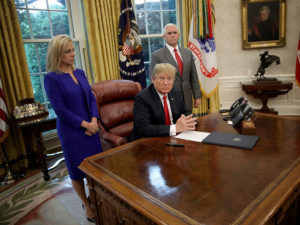Trump’s Executive Order “Family Separation”
The President Trump has announced on Twitter sign an executive order ending the practice of separating migrant families.
President Trump signed an executive order on Wednesday ending his administration’s policy of separating migrant children from their parents who were detained as they attempted to enter the U.S. illegally.
The action came after a firestorm of protest from administration opponents and allies, reacting to pictures and sounds of young children traumatized by their separation from their parents at the hands of U.S. authorities.
“So we’re going to have strong — very strong borders, but we’re going to keep the families together. I didn’t like the sight or the feeling of families being separated,” said Trump.
He is, in effect, ordering family separation to be replaced with the detention of whole families together, even after earlier arguing that “you can’t do it by executive order.”
The president says his administration is trying to balance rigorous enforcement of U.S. immigration laws and pursue its policy of maintaining family unity. He says his administration was put “in the position of separating alien families to effectively enforce the law” due to “Congress’s failure to act” and “court orders.”
The administration has consistently said that it was forced to separate families due to a court case known as “the Flores Settlement.” That settlement, reached in 1997, required the government to limit the time it kept unaccompanied minors in detention, and to keep them in the least restrictive setting possible. The settlement was later modified to say that children should not be held longer than 20 days.
Trump’s executive order directs the attorney general to promptly file a request with U.S. District Judge Dolly Gree in the Central District of California to modify the Flores Settlement and allow detained migrant families to be held together “throughout the pendency of criminal proceedings … or other immigration proceedings.”
The president directed Homeland Security Secretary Kirstjen Nielsen to maintain custody of detained families during criminal proceedings and as their asylum claims are adjudicated. Also, Secretary of Defense Jim Mattis and the heads of other agencies are ordered to find or construct facilities to house the detained families. Finally, Attorney General Jeff Sessions is directed to prioritize the adjudication of cases involving detained families.
After visiting Capitol Hill Tuesday nightto rally a broad immigration bill, Trump said Wednesday he still hopes that Congress will act.
“We will be going through Congress. We’re working on a much more comprehensive bill,” Trump said before signing the order. But as The Washington Post reports, few people are predicting either House measure will pass.
It is not immediately clear whether, or when, detained children will be reunited with their parents.
A spokesman for the Department of Health and Human Services, Kenneth Wolfe, told The New York Times that detained children won’t be joining their detained parents soon.
“There will not be a grandfathering of existing cases,” said Wolfe, as quoted by the Times.
Reyna Torres Mendivil, Mexico’s consul general in San Antonio, told NPR’s Audie Cornish that the process would be hampered by the U.S. separation process, which keeps parents in ICE custody while moving children into facilities controlled by the Department of Health and Human Services.
“The U.S. authorities create different files for the children than for the parents, and it’s very difficult to follow up on those cases,” Torres said.
Immigrant advocates say the president’s executive order is no solution, and will only create more trauma for children, as they will be placed in facilities that are unfit for minors.
“First, there are more than 2,000 children already separated from their parents; the executive order does nothing to address that nightmare,” said Michelle Brané, director of the Migrant Rights and Justice Program at the Women’s Refugee Commission. “Second, this executive order effectively creates family prisons, which we already know are a threat to the well-being of children.”
“The president doesn’t get any Brownie points for moving from a policy of locking up kids and families separately to a policy of locking them up together,” said Karen Tumlin, director of legal strategy at the National Immigration Law Center. “Let’s be clear: Trump is making a crisis of his own creation worse.”
Some on the right are equally dismayed.
According to any fair reading of the order, it represents a massive capitulation by the administration,” wrote National Review senior writer David French.
But Mark Krikorian, executive director of the D.C.-based Center for Immigration Studies, which supports less immigration, supported the president.
“Getting rid of the Flores Settlement is the quickest way to solve the problem,” Krikorian told The Washington Post. “The government has been faced with the choice of either splitting the family by detaining the parent and releasing the kid, or just letting the parent go too.”




